
Mantis shrimp, or stomatopods, are carnivorous marine crustaceans of the order Stomatopoda, branching from other members of the class Malacostraca around 340 million years ago. Mantis shrimps typically grow to around 10 cm (3.9 in) in length, while a few can reach up to 38 cm (15 in). A mantis shrimp's carapace covers only the rear part of the head and the first four segments of the thorax. Varieties range in color from shades of brown to vivid colors, with more than 450 species of mantis shrimps being known. They are among the most important predators in many shallow, tropical and subtropical marine habitats. However, despite being common, they are poorly understood, as many species spend most of their lives tucked away in burrows and holes.

The Chinese mantis is a species of mantis native to Asia and the nearby islands. In 1896 this species was accidentally introduced by a nurseryperson at Mt. Airy near Philadelphia, United States. Tenodera sinensis often is erroneously referred to as Tenodera aridifolia sinensis because it was at first described as a subspecies of Tenodera aridifolia, but Tenodera sinensis is now established as a full species.

The Alvand class or Saam class was originally a class of four frigates built for the Imperial Iranian Navy. They were renamed after the Iranian Revolution, and served in the Islamic Republic of Iran Navy during Iran-Iraq War. Three still remain in service. A fourth was sunk by the US Navy in 1988.

Empusidae is a family of plant-mimicking mantises, consisting of 10 genera, holding almost 30 species. Unlike many other mantis families, the Empusidae are a monophyletic lineage. Empusidae mantises are ambush predators, with mouthparts adapted to feeding on other insects and small animals. The majority of Empusidae species are distributed throughout Africa, but they are also found in Southeast Asia and in the southern parts of Europe.

The mantis family Metallyticidae consists of a single small genus, Metallyticus, living mostly in South-East Asia. The species are dark, somewhat flattened and cockroach-like, often with a cuticle that is reflective and metallic in appearance.

Amorphoscelidae is a family of mantises in the order Mantodea.

Flower mantises are those species of praying mantises that mimic flowers. Their coloration is an example of aggressive mimicry, a form of camouflage in which a predator's colours and patterns lure prey. The flower mantises are not a natural group with a single ancestor, but most of the species are in the family Hymenopodidae. Their behaviours vary, but typically involve climbing a plant, and then staying still until a prey insect comes within range. Many species of flower mantises are popular as pets.
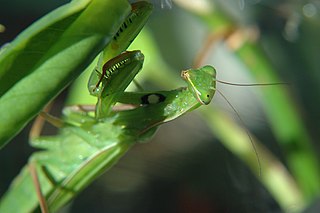
The genus Mantis is in the family Mantidae, of the mantis order Mantodea.

Orthodera ministralis, common name garden mantis or Australian green mantis, is a species of praying mantis from Australia. The garden mantis inhabits the whole of Australia, and can often be found hidden in leafy scrub from ground to eye level. It feeds on small insects by ambushing them.

Metallyticus splendidus is a rare species of praying mantis found in Southeast Asia. It has an iridescent appearance.
Sphodromantis annobonensis is a species of praying mantis in the family Mantidae. It occurs on the island of Annobón, Equatorial Guinea.
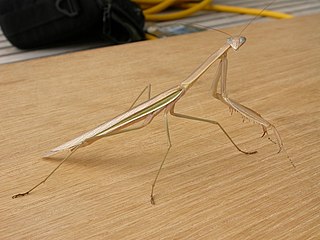
Tenodera australasiae, the purple-winged mantis, is species of praying mantis. Found in Australia, it is common in most parts of Brisbane (QLD). Both males and females are capable of flight. The species has not been shown to be parthenogenetic.

Lysiosquillina maculata, the zebra mantis shrimp, striped mantis shrimp or razor mantis, is a species of mantis shrimp found across the Indo-Pacific region from East Africa to the Galápagos and Hawaiian Islands. At a length up to 40 cm, L. maculata is the largest mantis shrimp in the world. L. maculata may be distinguished from its congener L. sulcata by the greater number of teeth on the last segment of its raptorial claw, and by the colouration of the uropodal endopod, the distal half of which is dark in L. maculata but not in L. sulcata. A small artisanal fishery exists for this species.
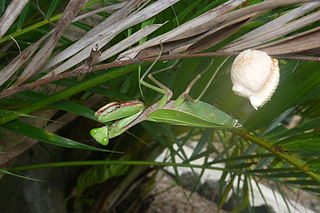
Hierodula majuscula is a species of praying mantis in the genus Hierodula. It is also known as the giant rainforest mantis and the Australian giant mantis. It is found in coastal northern Australia, usually in rainforest and adjacent habitats. This species is typically green although a less common bright yellow form does occur.
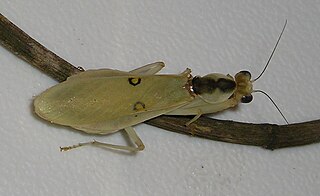
Chloroharpax is a genus of praying mantis in the family Hymenopodidae. The genus is monotypic, being represented by a single species, Chloroharpax modesta, commonly called the Nigerian flower mantis, and is found across West Africa.

Acanthopidae is a family of mantises consisting of 16 genera in the order Mantodea. The group was first formally split off as a separate family by the German entomologist Reinhard Ehrmann in 2002. In 2016, five genera were moved from Acanthopidae to the newly created family Acontistidae, but this has not been accepted in most recent classifications.

Mantises are an order (Mantodea) of insects that contains over 2,400 species in about 430 genera in 33 families. The largest family is the Mantidae ("mantids"). Mantises are distributed worldwide in temperate and tropical habitats. They have triangular heads with bulging eyes supported on flexible necks. Their elongated bodies may or may not have wings, but all Mantodea have forelegs that are greatly enlarged and adapted for catching and gripping prey; their upright posture, while remaining stationary with forearms folded, has led to the common name praying mantis.
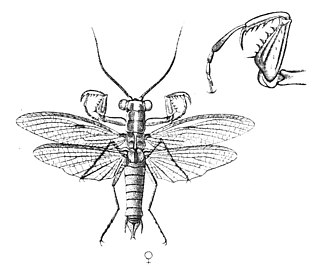
Mantoididae is a family of order Mantodea which contains Neotropical species of praying mantises from tropical North and South America. The family was formerly represented by the sole genus Mantoida, however the genus Paramantoida was described in 2014 and Vespamantoida in 2019. The family differs from the closely related Chaeteessidae in having an apical claw on the fore tibiae which are also less curved. Males have ocelli and a cylindrical body shape, unlike the dorsoventrally flattened Chaeteessidae. The cerci are also shorter.
Qatar-3 is a faint 12th magnitude star located in the northern constellation Andromeda. It is host to a transiting planet. With a radial velocity of 10.99 km/s, it is currently drifting away from the Solar System, and is currently located 2,400 light years away based on parallax.















